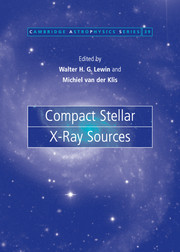Book contents
- Frontmatter
- Contents
- List of contributors
- Preface
- 1 Accreting neutron stars and black holes: a decade of discoveries
- 2 Rapid X-ray variability
- 3 New views of thermonuclear bursts
- 4 Black hole binaries
- 5 Optical, ultraviolet and infrared observations of X-ray binaries
- 6 Fast X-ray transients and X-ray flashes
- 7 Isolated neutron stars
- 8 Globular cluster X-ray sources
- 9 Jets from X-ray binaries
- 10 X-rays from cataclysmic variables
- 11 Super-soft sources
- 12 Compact steller X-ray sources in normal galaxies
- 13 Accretion in compact binaries
- 14 Soft gamma repeaters and anomalous X-ray pulsars: magnetar candidates
- 15 Cosmic gamma-ray bursts, their afterglows, and their host galaxies
- 16 Formation and evolution of compact stellar X-ray sources
- Author index
- Subject index
12 - Compact steller X-ray sources in normal galaxies
Published online by Cambridge University Press: 01 September 2009
- Frontmatter
- Contents
- List of contributors
- Preface
- 1 Accreting neutron stars and black holes: a decade of discoveries
- 2 Rapid X-ray variability
- 3 New views of thermonuclear bursts
- 4 Black hole binaries
- 5 Optical, ultraviolet and infrared observations of X-ray binaries
- 6 Fast X-ray transients and X-ray flashes
- 7 Isolated neutron stars
- 8 Globular cluster X-ray sources
- 9 Jets from X-ray binaries
- 10 X-rays from cataclysmic variables
- 11 Super-soft sources
- 12 Compact steller X-ray sources in normal galaxies
- 13 Accretion in compact binaries
- 14 Soft gamma repeaters and anomalous X-ray pulsars: magnetar candidates
- 15 Cosmic gamma-ray bursts, their afterglows, and their host galaxies
- 16 Formation and evolution of compact stellar X-ray sources
- Author index
- Subject index
Summary
Introduction
In the 1995 X-ray Binaries book edited by Lewin, van Paradijs and van den Heuvel, the chapter on Normal galaxies and their X-ray binary populations (Fabbiano 1995) began with the claim that “X-ray binaries are an important component of the X-ray emission of galaxies. Therefore the knowledge gathered from the study of Galactic X-ray sources can be used to interpret X-ray observations of external galaxies. Conversely, observations of external galaxies can provide us with uniform samples of X-ray binaries, in a variety of different environments.” This statement was based mostly on the Einstein Observatory survey of normal galaxies (e.g., Fabbiano 1989; Fabbiano, Kim & Trinchieri 1992). Those results have been borne out by later work, yet at the time the claim took a certain leap of faith. Now, nearly a decade later, the sensitive sub-arcsecond spectrally resolved images of galaxies from Chandra (Weisskopf et al. 2000), complemented by the XMM-Newton (Jansen et al. 2001) data for the nearest galaxies (angular resolution of XMM-Newton is ∼15″), have made strikingly true what was then largely just wishful anticipation.
While a substantial body of ROSAT and ASCA observations exists, which was not included in the 1995 chapter, the revolutionary quality of the Chandra (and to a more limited degree of XMM-Newton) data is such that the present review will be based on these most recent results.
- Type
- Chapter
- Information
- Compact Stellar X-ray Sources , pp. 475 - 506Publisher: Cambridge University PressPrint publication year: 2006
- 40
- Cited by

